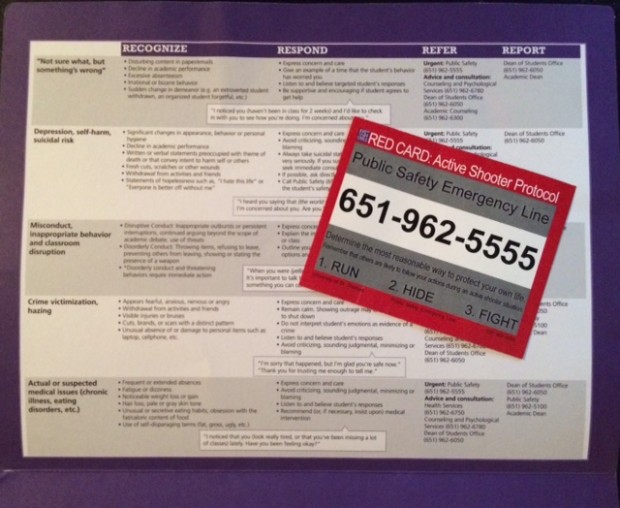
Vice president of Student Affairs Karen Lange and Director of Public Safety Dan Meuwissen gave a presentation at an all-staff forum last Tuesday on how to respond to an active shooter.
The presentation was added to the forum in response to recent shootings at Umpqua Community College in Oregon, Northern Arizona University and Texas Southern University. Lange also works closely with the University Action and Response Team (UART) and said it is important to discuss the issue.
“My sense is, as I was talking, that people were listening and cared a lot about the information,” Lange said. “We were able to give out some resources to people, and everybody took them on the way out.”
Staff members were given a purple folder containing guidance on how to recognize, respond, refer and report in the event of a crisis; the folders also contained a number of resources to contact during an emergency.
Run, Hide and Fight
Additionally, red cards, labeled Active Shooter Protocol, were distributed with the Public Safety emergency line and a list of three steps to follow: run, hide and fight. That protocol is part of a nationwide shift in how to respond to an active shooter. In the past, the emphasis was to hide first.
Brad Pulles, who works with Student Diversity and Inclusion Services, said the three steps might make it easier for people to remember how to respond in the event of an active shooter.
“I think the really nice thing is having those three main steps of run, hide and fight,” Pulles said. “It makes it a little bit easier for people to remember what to do when something like that happens, so people know how to respond in a really potentially stressful situation.”
Pulles left the forum knowing that he should speak with his department about specific response plans in various emergencies.
“I think that’s really important that the different departments on campus really have a plan,” Pulles said.
Faculty to be included
Although faculty members were not present at the forum, Lange said she is working on setting up meetings with each academic department in order to make sure this information reaches all members of the university.
“We have done faculty training at their request, but it hasn’t been systematic in terms of reaching every single faculty member,” Lange said. “That’s the direction we need to go. We really need to get this information out to all faculty and staff, and we have a good start on that, but we still have a ways to go.”
Theology professor and Chair of the Faculty Senate David Landry thinks addressing each department would be effective because it is difficult to find times that accommodate every faculty member’s schedule.
“If you try to get six or eight faculty members on a committee to go to a meeting, it’s almost impossible unless you use convo hour,” Landry said. “But the thing about convo hour is it’s almost always taken up by something else.”
Landry recalls that the university used a similar informational process when the new sexual harassment and sexual violence policy came out.
“(They talked) to us for 45 minutes to an hour, and it was very informative, and that was a great way to catch everyone in our department,” he said. “I feel like we were well-trained on that particular issue, so if they’re going to do something for the active shooter scenario then I think that would be a very good way to handle it.”
Lange said Public Safety and UART will offer in-depth training to anyone on campus.
“Faculty, staff and students, it’s not on your mind constantly, but of course you think about it,” she said. “It’s really about people mentally preparing for if something would happen here.”
Margaret Galush can be reached at galu4637@stthomas.edu.



